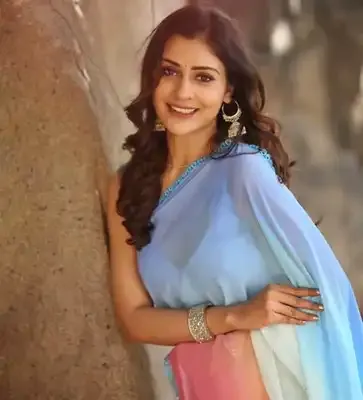Take a look around the next time you’re on the road and you’ll likely find yourself in a sea of sameness, but not just in terms of crossover and SUV popularity. Today, we’re talking about popular car colors along with those that have fallen out of favor. Turns out, as you have now surely noticed, grayscale is in, and vibrancy is out. By grayscale, we mean white, black, gray, or silver, and by in we mean that some 80% of cars sold in 2020 — globally — are finished in these grayish tones.
Advertisement
According to iSeeCars, that 80% figure was closer to 60% back in 2004, a metric backed up by Axalta’s 68th Global Automotive Color Popularity Report, which puts the percentage at 81. Drilling down into the U.S. market specifically, Edmunds finds an identical number, but that doesn’t mean all hope is lost on colorful cars. Coatings manufacturer BASF notes in its 2024 Automotive Color Trends study that we may be in for a brighter future when it comes to popular car colors.
It anticipates novel new shades such as Zenomenon that “will pull through with invigorated structure to bring to light the phenomenon of color purely perceived as the result of light dancing between microscopic structures.” Interesting. Also interesting are the $14,000 Porsche paint jobs and the extinction of beige Toyotas, which we’ll cover below. We’ll also touch on what makes a given color easy to maintain (or not) and considerations to keep in mind when choosing your car’s color. Much of this insight comes from decades of personal experience with all manner of car finishes.
Advertisement
White
White is the most popular car color, by far, across the globe, with a 38% market share. According to iSeeCars, white cars command 27.6% of the U.S. car market, representing a 77.4% increase since 2004. That percentage is higher for trucks at 30.9% in 2023 but lower among sports cars, where white has a 19.4% market share. There are a host of reasons behind the popularity of white, but a notable explanation is that the radar and LiDAR technologies behind the ever-growing advanced driver assistance systems work better with a white car.
Advertisement
Some point to more subjective reasoning like consumer desire for simple colors in turbulent times. Of course, white is better at reflecting heat than dark shades, and when you consider that Americans are migrating to Sun Belt states in large numbers, it’s less surprising. According to Edmunds, white has 30% of the car color market in toasty Arizona versus 21% in cooler climes like Maine.
The upside to owning a white car is that when it’s clean, boy, can it look sharp. This is especially true for owners of the latest Yukon Denali who opt for the $1,095 White Frost Tricoat finish and its iridescent vibe. However, you don’t need to be a gearhead to understand that white paint is just about the worst option for hiding dirt. For now, given its number one spot in the car color popularity charts, many buyers may struggle to find a vehicle that isn’t white.
Advertisement
Black
The yin to white’s yang, black is the second most popular car color globally, with 19% of the market share, and stateside at up to 23%. Unlike white, which can be viewed as somehow boring or uninspired, black is often associated with luxury if the limousine market is any indication. It’s a color that crosses over disparate vehicle segments, too, with 20% of the truck market and 19% of the sports car market in 2023.
Advertisement
One reason for this is that a clean black car can often be second to none when it comes to visual pop. The reverse is also true, as dirt does not disappear into a black finish, and if you’ve ever seen a black car coated in yellow pollen, well, you know how bad it can get. Black is also widely known for becoming incredibly hot when left outside on a sunny day, so those living in southern states should keep that in mind.
For those who dig this dark shade, Infiniti recently offered a limited edition of its long-in-the-tooth Q50 that promises to be spectacular on a sunny day. Dubbed Black Opal Metallic, the automaker notes the color shifts across the blue, green, and purple spectrum. Exclusive to the Q50 Red Sport 400 package, which costs $8,000 more than the next option, this particular car color may not be for everyone. In fact, given how black has plateaued in popularity at around 22% since 2012, perhaps this could be one of the first colors to experience BASF’s prediction of a shift into the world of Zenomenon hues.
Advertisement
Gray
The namesake color of grayscale’s paint popularity, gray currently owns 20% of the U.S. market share and 15% across the globe. It’s also been the most explosive market share gainer, increasing by nearly 82% between 2004 and 2023. Some of that gain could be chalked up to Audi’s much-lauded Nardo Gray finish that debuted in 2013 and ushered in an era where gray became cool. Toyota followed up years later with Cement, a color that for a time was exclusive to its range-topping TRD Pro vehicles.
Advertisement
Eight years later, Toyota has disseminated its Cement gray paint throughout its lineup, including for more mainstream models like the Grand Highlander. None of this seems to have diminished its popularity, as the trend line is still pointing up. Reinforcing that point is that within the sports car segment, gray paint is, in fact, the most popular car color, with a 20.1% market share as of 2023.
It is interesting when you consider that sports cars have historically been more famous for finishes in the arrest-me red section of the paint palette. But, when you consider that the percentage of sports cars painted red in the U.S. has dropped from 22% in 2004 to 14.3% as of 2023, it’s less surprising. Keep in mind that although gray does a nice job of concealing dirt, it can make your ride less visible on the road for other drivers, which is concerning in this age of distracted driving.
Advertisement
Silver
Silver comes in so many varieties it can be hard to distinguish it from gray and even some blues. Take the Lexus LS and its old-school luxury, for example. It can be painted in three different shades of silver, including Atomic Silver and Iridium. But Silver Illusion, a $3,100 optional finish, is perhaps one of the silveriest of all, and owners say it must be seen in person to fully appreciate it.
Advertisement
For reasons unknown, while shades of gray have exploded within the car color community over the past 20 years, silver and its relatively similar hues have done the opposite. Silver has decreased in popularity from 19% of overall U.S. market share in 2004 to about 9% today. That 52% decline is nearly identical for SUVs and even steeper within the passenger car segment at 58.9%.
Edmunds says silver is slightly more popular in the U.S. at 14%, but it remains under 10% globally. So, silver isn’t as popular as it once was, but it is a fine choice for hiding dirt and tends to make minor paint imperfections — scratches and dents — less obvious. If BASF’s color trend study is any indication, however, we may start to see an uptick in the silver family of car colors with tangential hues like transparent blues and other lighter shades.
Advertisement
Blue
Sitting in fifth place for most popular car colors in the U.S. is blue, a shade that comes in seemingly countless varieties. With the Honda Pilot alone, buyers can choose from Obsidian Blue Pearl for no extra charge or Diffused Sky Pearl if they’re willing to pay the $455 surcharge. It also requires stepping up to the TrailSport variant with its off-road aspirations as Honda limits access to this head-turning color exclusively for the TrailSport.
Advertisement
Love this particular color or not, blue is the Goldilocks of car colors. It’s not too gray and dull, not too crazy plum purple, but just right. Skilled at concealing dirt and scuffs, the right (wrong?) shade of blue can also be tough to spot in low-visibility conditions, which is something of a safety concern for owners.
Representing 9% of U.S. car colors and 10% globally, blue paint has meandered within this market share range for more than 20 years. That makes blue a classic paint color that could become more popular in the coming years. According to BASF and its On Volude collection of trending car colors, along with the bluish Zenomenon color seen as a next-gen North American style, the Asia Pacific region’s key color is Electronic Citrus. It is said to reflect the area’s positive attitude, as a light green hue that features airy blue highlights.
Advertisement
Beige
Eight years ago, Toyota CEO Akio Toyoda declared a ban on boring cars in an effort to bring some excitement to the automaker’s lineup. One result of that directive is that today, you can no longer buy a beige Camry. Long the poster child for blandness, Camry’s finished in beige once prowled American roads in droves. According to Edmunds, it doesn’t even register within the top 12 most popular car colors at this point — and the shade yellow only owns 0.08% of the market.
Advertisement
To be fair, studies show that the percentage of beige was only 3.4% in 2004 and has slid more than 86% since. Though this massive decline cannot be entirely chalked up to Mr. Toyoda’s assault on boringness, more than 309,000 Camrys found their way to customer driveways in 2024. So, its lack of a beige finish option certainly didn’t help, which some may find unfortunate, as the understated — and underappreciated — hue is great at hiding dirt, making it ideal for those who enjoy off-roading or just don’t like wishing their car.
The truth is, beige hasn’t entirely disappeared from automaker lineups. Instead, it has undergone a rebranding to avoid the perceived negative connotation. Take the new off-road-centric Mazda CX-50, for example, and the $450 optional Zircon Sand Metallic developed just for this crossover. “The striking, earthy tone is tan with some yellow aspects,” says Mazda. It sounds like beige to us, but maybe Mazda can turn beige’s fortunes around.
Advertisement
Brown
There are car colors that lean brown, but don’t come right out and say it. Looking at you, Toyota Tundra 1794 Edition coated in Smoked Mesquite. Then there is Mercedes-Benz and its word-salad MANUFAKTUR Signature Dakota Brown Magno finish. Magno translates to “matte” and MANUFAKTUR Signature means expensive, as in $6,500 for this particular shade.
Advertisement
It’s offered on the Mercedes-AMG G 63, a big blocky SUV that starts north of $180,000, so perhaps the paint cost is a moot point to buyers. Not to mention the extra work required to properly maintain a matte automotive finish. But this high barrier to access isn’t doing brown any favors in the popular car color department. iSeeCars says brown only captures 0.4% of the U.S. market, while Edmunds gives it a tiny boost to 0.9%.
Certainly, if you were to take the G 63 off-road, the right shade of dirt would practically disappear. But more likely considerations around owning a brown car is questionable resale success as some shades of brown look, shall we say, unfortunate. However, global coatings company PPG suggests that here in the Americas the popular gray palette will soon shift to warmer colors with a brown vibe due to consumer tastes leaning toward organic tones. Time will tell.
Advertisement
Yellow
Yellow hasn’t been part of the popular car color club for at least the past 20 years. As of 2004, yellow accounted for less than 1% of the overall market, a figure that dropped precipitously to just 0.2% last year. That number doesn’t change much within specific vehicle segments like trucks, SUVs, and passenger cars. However, within the sports car segment, yellow fares better with 2% of the market. That may not come as a surprise as yellow is something of an attention-grabbing color, making it well-suited to this arena.
Advertisement
That said, you needn’t pay big bucks for a fancy yellow finish on your sports car. Just look at the highly lauded Hyundai Kona and its available Neoteric Yellow paint job. An extra $500, this color has been on the Kona palette since it debuted in 2018 and is hard to miss on the road with its bright, vibrant hue. On certain vehicles, like a Porsche, for example, a unique yellow finish could improve resale value down the road as it adds a certain uniqueness that high-end buyers might appreciate.
But be careful painting a car like the Kona yellow. Given its mainstream mission and high affordability, you could end up turning off more would-be buyers than with a popular grayscale shade. One last note to be aware of with a yellow paint job is that there’s no hiding dirt with it. If you do go the yellow route, though, the increased visibility doesn’t hurt in the safety department, with so many staring at their phones while driving.
Advertisement
Gold
Part of the yellow family of car colors, gold can also make resale a challenge, and regular upkeep is required to keep it shimmering. But for a car that you can’t miss, it’s hard to beat a gold finish. Currently sitting in the 10th position of most popular car colors in America with 0.1% of the U.S. market share, gold follows yellow with a massive 20-year decline in overall popularity.
Advertisement
It’s a similar story globally, where gold only accounts for 2% of the market share. But if you’re going to go for the, ahem, gold, why not go with an icon like the Porsche 911? The German automaker is known for offering a breathtaking array of paint choices, including one-off custom colors for serious money. But for just $14,190, you can coat your new 911 in the striking shade of Nordic Gold Metallic.
Based on the Gold Metallic finish Porsche featured in the early 1970s, it is also said to parallel the brass alloy shimmer found on 10-, 20-, and 50-cent Euro pieces. Eagle-eyed Porschephiles may recognize Nordic Gold as the communication color Porsche used on official press photos of the 997 generation 911 Targa 4S. Described as warm and shiny with yellow, orange, and red shades that give it the look of pure gold, we can’t think of a better choice for the 911.
Advertisement
Purple
Purple has the unfortunate distinction of being one of the least popular car colors across the industry. iSeeCars says purple owns 0.1% of the market, Edmunds pegs it at 0.09%, and the American Coatings Association doesn’t even mention it. Interestingly, that’s not quite the case with BASF and its hyper-abstract On Volude color trends study.
Advertisement
Though there is no reference to purple, the company uses words like Predictor and Zenomenon to describe these trending colors. A look at the visuals shows clear purple hues in the mix. That doesn’t necessarily mean purple is on a comeback tour as its highest market share by segment is in sports cars and that figure is only 0.8%.
For those who think purple is defined by Mopar and its widely known Plum Crazy muscle car color, know that purple comes in more than one shade. Take the new-for-2025 Molten Magenta Metallic Tri-Coat that Ford offers across the Mustang range for $995. Also available on the Mustang Mach-E, this deep purple-pink hue reminds of Porsche’s Ruby Star Neo. Purple may not be for everyone, but it certainly doesn’t lack visual punch.
Advertisement








